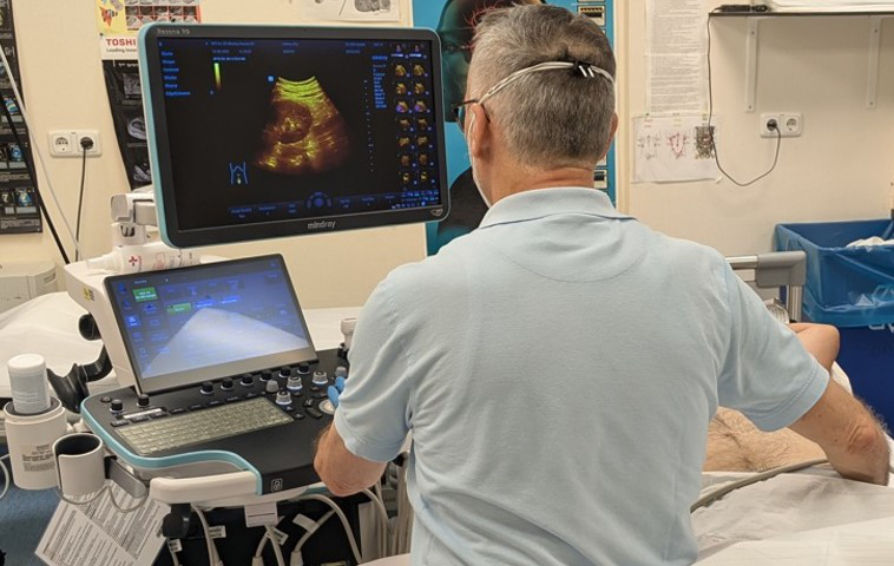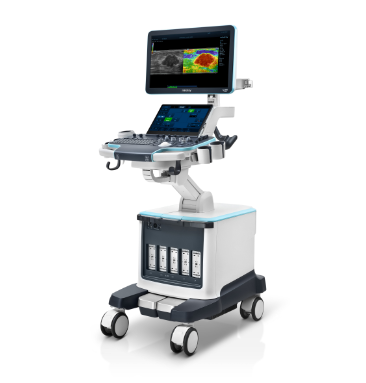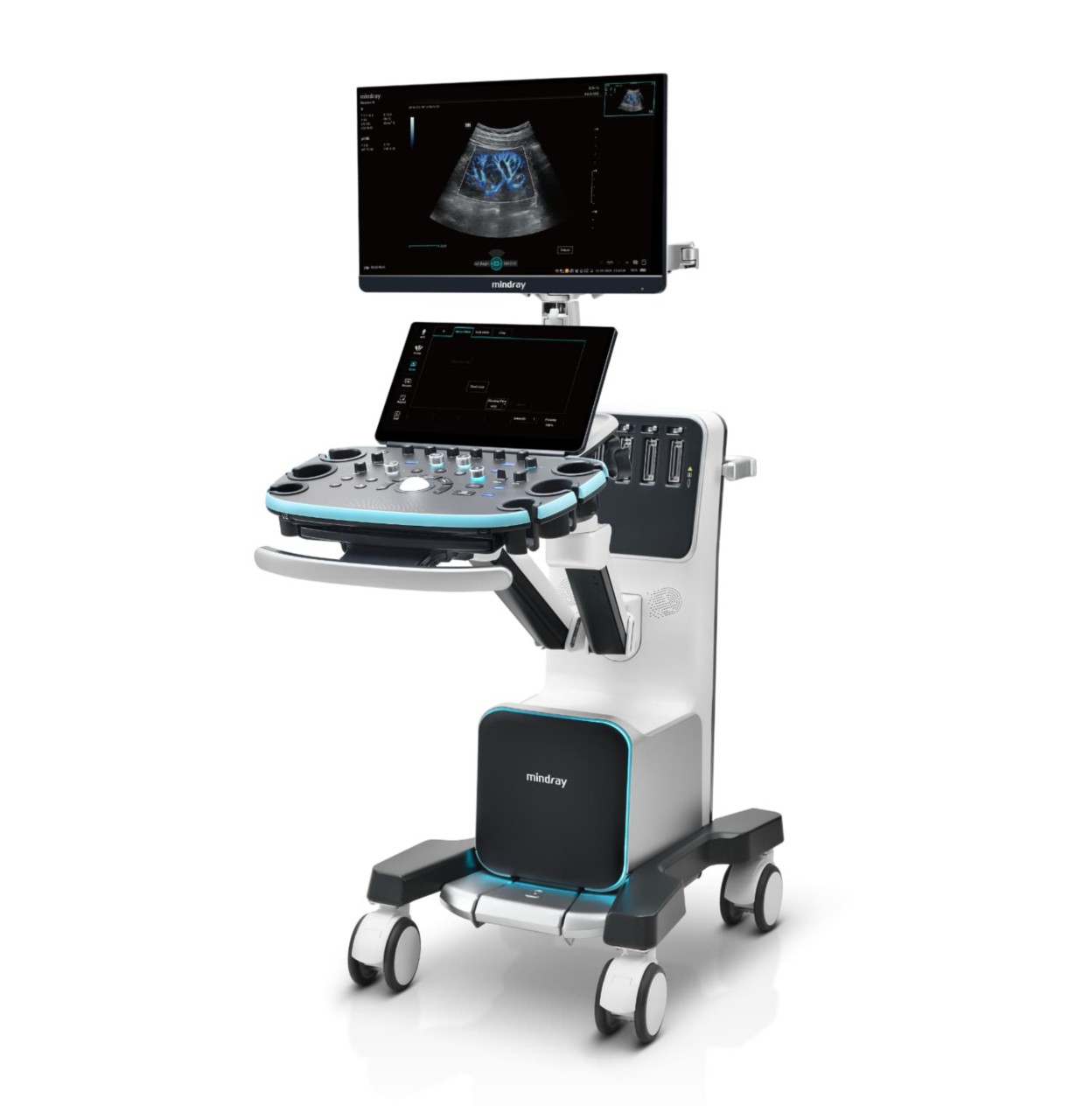With around 35,000 ultrasound examinations per year, the Central Interdisciplinary Sonography Department (ZiS) at the Krankenhaus der Barmherzigen Brüder Trier is the largest department of its kind in Germany [1,2]. After nearly two decades of service, Dr. Matthias Wüstner, Head Physician of the ZiS, has now retired – the perfect opportunity to talk to him once more about the ultrasound technology that has supported his department’s success..
When Wüstner began his work in Trier on January 16, 2006, he was amazed at the special development the hospital’s sonography organization had undergone.
Dr. Matthias Wüstner
Head Physician of the Central Interdisciplinary Sonography Department at the Hospital Krankenhaus der Barmherzigen Brüder Trier
When real-time sonography came onto the market in the 1970s, a nuclear medicine physician at the Brothers Hospital in Trier, Dr. Wolfgang Jammers, was the first to adopt the method. Driven by his enthusiasm for ultrasound, he developed such a high level of expertise that no one in internal medicine, radiology, or any other specialty could match him.
Ultrasound on Unconventional Paths
This did not go unnoticed by the various clinical departments, which increasingly sent their patients to nuclear medicine for ultrasound diagnostics. Dr. Jammers seized this opportunity, secured additional physician positions, and eventually became Head of the “Nuclear Medicine” department – which, despite its name, was responsible for nearly all ultrasound diagnostics in the hospital (except for cardiac echo). At the time of his untimely death in 2004, the department consisted of six physicians, including himself.
Afterwards, surgeon Matthias Wüstner and internist Elmar Mertiny jointly established the Central Interdisciplinary Sonography Department; nuclear medicine had by then become its own division. Today, as a section within the Center for Radiology, Neuroradiology, Sonography, and Nuclear Medicine, the ZiS employs about eleven full-time physicians who perform an average of 130 ultrasound examinations on weekdays and around 30 on weekends or holidays — about 35,000 per year. Few facilities in Germany can match these numbers.
High-End Instead of High Quantity
Anyone visiting the department will quickly notice: the number of ultrasound machines is limited. “Yes, we have only a few stationary systems, but they are all high-end devices that run all day long,”confirms Wüstner with a smile. “That’s what sets us apart from other hospitals, where many chief physicians have a big system that’s only switched on twice a week during private consultation hours.”
Currently, one Resona R9 and three Resona I9 Elite systems form the backbone of ultrasound diagnostics at the main workstations. In addition to reference diagnostics, contrast-enhanced imaging, and a wide range of percutaneous interventions, the latest generation of devices has also enabled new specialized liver diagnostic methods, including fatty liver quantification, to be integrated into the department’s portfolio.
However, finding the right technology took several years. “The situation was complicated,” recalls Wüstner. “The purchase was repeatedly postponed because we couldn’t reach agreement within the department and budgets weren’t approved. Only when the old machines literally started falling apart,did things finally start moving.”

Why Mindray Was Chosen
The decisive factor in favor of the Mindray Resona systems was the ZONE Sonography Technology+ (ZST+). Once contrast imaging was integrated, this technology revealed its full potential across the entire range of ZiS applications. The accelerated image acquisition frees up computing power for detailed image optimizations, improving both image and diagnostic quality while simplifying workflow for users.
Apart from clearer B-mode details and more distinct tissue differentiation, the current generation offers unprecedented sensitivity in depicting blood flow and other motion phenomena in astonishingly fine resolution. “Because the system can fully ‘focus through’ every image frame despite the high frame rate, manual image focusing becomes unnecessary. That simplifies (and improves) the work enormously, even for less experienced users,” explains Wüstner.
For Wüstner, however, the most important innovation introduced by the Resona R9 is Attenuation Imaging, which enables quantification of fat content in the liver – regardless of whether the right kidney is present and healthy: “Previously, this was only possible with MRI. Being able to assess fat content now with a much simpler, faster, and more cost-effective technique like ultrasound is a major breakthrough for liver patients and their physicians,” says Wüstner.
The Resona I9 systems already in use have since been upgraded with the software originally developed for the R9 for fat quantification – a measure initiated by Wüstner during his tenure.
Despite all the technological sophistication, ease of handling in daily clinical practice remains crucial. When choosing the right system, one factor is particularly important: intuitive operation. “It’s like driving a car,” explains Wüstner. “When driving, you have to keep your eyes on the road and find all the controls by instinct. An ultrasound machine should offer the same – so that the examiner’s gaze can stay focused on the image monitor instead of searching for buttons on a touchscreen. That’s how a true success story begins.”
Profile
After studying medicine in Göttingen, Dr. Matthias Wüstner worked from 1987 to 2006 at the university surgical clinics in Göttingen (as specialist) and Mannheim (as senior physician). In 2006, he became Head Physician of the Central Interdisciplinary Sonography Department at the Hospital Krankenhaus der Barmherzigen Brüder Trier. Wüstner is a DEGUM (German Society for Ultrasound in Medicine) seminar leader / Level III in the Surgery Section and was DEGUM-Delegate from 2015 – 2021 and until 2023 active as Committee Chairman in EFSUMB* (EFSUMB – European Federation of Societies for Ultrasound in Medicine and Biology)
References:
[1]. Wüstner M, Mertiny E, Busch HP: Klinikarzt 2012; 41 (1): 15–59
[2]. Clevert DA, Jung EM, Weber M et al. Concepts in the Establishment of Interdisciplinary Ultrasound Centers: The Role of Radiology. Fortschr Röntgenstr 2022; 194: 1322–1332


